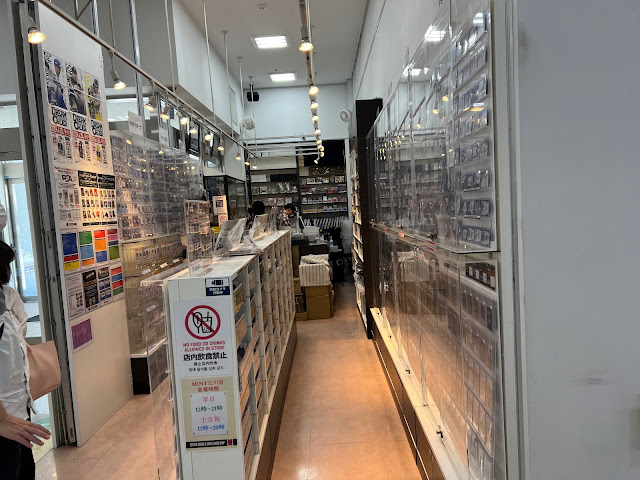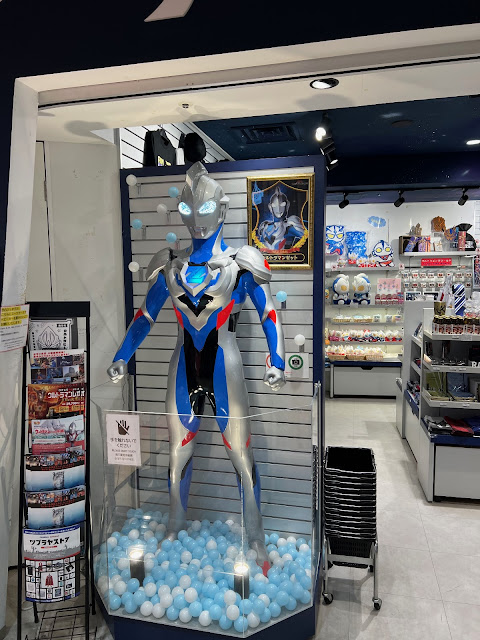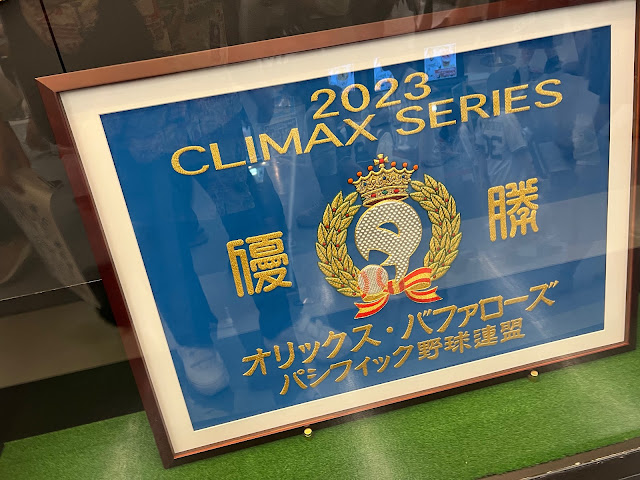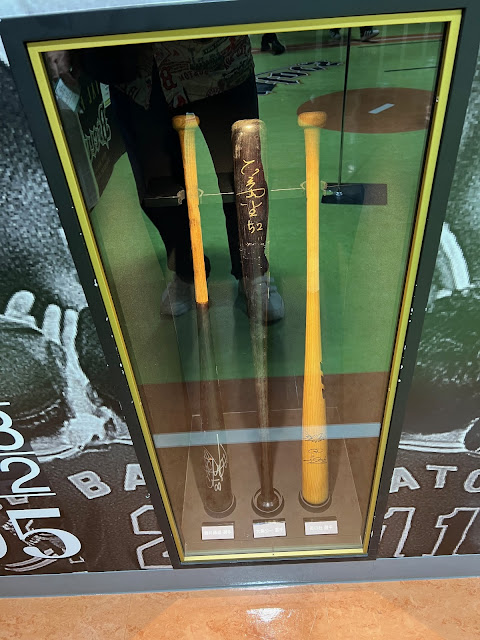Monday, July 29, 2024
New Tomoyuki Sugano Card From Panini
Sunday, July 28, 2024
Card Of The Week July 28
The NPB All Star games were held last week. Tuesday's games was at the Fighters' new ballpark in Hokkaido and Wednesday's game was at Jingu Stadium in Tokyo and both games featured a lot more scoring than has been the norm this year. The Central League won 11-6 on Tuesday while the Pacific League won 16-10 the following day. There were six home runs hit in each game, including two each by Shugo Maki (both on Tuesday), Hiromi Oka (one in each game) and Munetaka Murakami (also one in each game).
It was in a losing effort, but Shogo Sakakura of the Carp made history on Wednesday by hitting just the third grand slam in All Star history. The first one was hit in 1963 by Kihachi Enomoto of the Daimai Orions. It also was in a losing effort and was one of two home runs he had in the game. The last player to hit an All Star grand slam before Sakakura was Katsuo Ohsugi of the Toei Flyers in 1967. His home run off of rookie Yutaka Enatsu in the fourth inning put the PL out to a lead they would never relinquish and he ended up the MVP of the Pacific League's 9-6 victory.
Here are cards of all three players to hit All Star grand slams:
 |
| 1958 JCM 68 |
 |
| 2007 BBM Home Run Chronicle #09 |
 |
| 2020 Epoch Carp Rookies & Stars #20 |
Thursday, July 25, 2024
Card Shops In Japan: Mint Tachikawa
Please check my "Card Shops in Japan" page before planning a trip to this store to verify that it's still where it was when I visited.
Mint Tachikawa is located - appropriately enough - in Tachikawa, a city west of Tokyo-city (but still in Tokyo prefecture) on the JR Chuo line. It was not a store that really registered on my radar but when I realized Ryan and I could easily swing by it on our way from Toho Studios to Seibu Dome on my first full day in Japan, I decided to check it out.
Ryan did posts on the store back in 2012 and 2014 but the store has moved a few blocks to the west since then, It is now located on the first floor of the Park Avenue shopping mall which is located roughly a quarter mile northwest of the JR Tachikawa station:
You can walk all the way to the mall from the station on an elevated walkway but you'll need to drop down to the ground floor to find the shop.
If you look carefully at the second photo, you can see Ryan in the back of the store, opening his packs of Dream Order cards.
As you can see, the store is very small. It's pretty much a "Mall Shop With Only Hits". Ryan and I both bought some unopened Dream Order products - packs and starter decks - at the store but it wasn't a place where I was going to knock off anything from my want list. I don't think they had any singles from recent sets but I could have missed them.
The shop is not conveniently located to central Tokyo - it's about a half hour train ride from Shinjuku station. But if you're in the area to check out Tachikawa Airfield or Showa Kinen Park or just passing through on your way to Seibu Dome and want to get the latest packs or boxes, it's worth stopping by.
Here's a map of the store's location:
Wednesday, July 24, 2024
Late Summer & Early Fall Releases
Tuesday, July 23, 2024
Trip Overview Part 5 - Day 7 - Osaka
Friday, May 17th, found me on the road again. Or, more accurately, on the Shinkansen again. I caught the Hirari 631 heading west from Nagoya at about 8:15 that morning. It was a beautiful day and while the scenery didn't include Mount Fuji, it was still nice to see some more rural areas than the usual urban sprawl.
This photo was taken as we passed through Sekigahara which is in a valley that passes through the mountains and historically has been the main route between western and eastern Japan. The Battle Of Sekigahara, which marked the start of the Tokugawa Shogunate (and was featured in James Clavell's novel "Shogun" and its various adaptations), happened near here. Those are the Ibuki mountains in the background.
The Shinkansen route descends from Sekigahara, passes by Lake Biwa and runs into Kyoto. I've never stopped there but I did take this picture as we passed by:
The train arrive at the Shin-Osaka station a little before 9:30 and I hopped on the subway to head to my hotel to drop off my bags. I was staying at a Toyoko Inn just north of Umeda station - it was the same one that I had stayed at in 2019 so I was familiar with how to get there.
My first stop after dropping off my luggage was Mint Umeda which is located in the Hankyu Sanbangai Mall just north of Umeda Station. Since this was just a few blocks south of my hotel, I walked there. On my way, I noticed the ferris wheel on top of the Hep Five shopping mall sticking out from behind some buildings:
I was happy to see that Mint Umeda still had an Ultraman store as a neighbor:
After leaving Mint Umeda, I got back on the subway to head to the Daimaru Shinsaibashi department store, home of Osaka's other Mint store - Mint Daimaru Shinsaibashi. (I'd make fun of the unoriginal name but since my blog is called "Japanese Baseball Cards", I don't feel I have any room to talk.) The store is located a few blocks north of Dotonbori canal and Namba Parks, the shopping mall built on the site of Osaka Stadium. (Since I'd been to both places in 2019, I didn't see any reason to go back this trip.)
After a very short visit to that Mint store, I headed over to the Shinsaibashi PARCO mall just next door. There's a Godzilla store there and I was looking for something to get my wife's 12 year old great-nephew who was a big kaiju fan. I had visited a Godzilla store my first evening in Tokyo a week earlier but not seen anything that I thought he'd like (well, actually, I saw a lot of things that I thought he might like but most were WAY out of my price range).
The Godzilla store was on the sixth floor of the mall and it was kind of interesting that there were a number of other pop culture-ish stores there including a Lego store, a Ghibli store, stores for various manga/anime properties and yet another Ultraman store:
The Godzilla store seemed a little larger than the one I went to in Shinjuku.
I ended up buying my wife's great-nephew a t-shirt and a large postcard for the store. I thought he might like the bag too:
I also ended up buying something for my granddaughter at the Ghibli store -
I got her the Catbus bib and a Totoro rattle.
I grabbed some lunch at the food court in the basement of the mall before heading to my next destination - an antique toy store called Kinkies that was a little ways away from the heart of Osaka. I'll write more about that store in another post but I had a great time there.
After leaving Kinkies, I headed back into Osaka proper to check into my hotel and relax before making my way to Osaka Dome for that night's Orix Buffaloes - Tohoku Rakuten Golden Eagles match up.
I had been somewhat stymied on my previous trip to the Dome - I had been under the impression there was some sort of Orix baseball museum there but I had been unable to locate it. But last year Deanna went to a game there and tweeted out some photos of old Hankyu Braves stuff so I made sure I got information from her on where to go. It's on the lower level of the park and you actually don't need a ticket to get to it. It's the same level that the team's main store is on. It's not a "museum" as such but there's a couple of spots that have old Hankyu and Kobe-era Orix stuff as well.
Some of the stuff is in the area where the fan club members line up to get stuff so I needed to explain that I just wanted to get photos of the pennants.
I'm curious - Orix/Hankyu has won five Nippon Series titles - 1975, 1976, 1977, 1996 and 2022. Three of those championship pennants are here (1977, 1996 and 2002). The 1975 pennant is over in the Hankyu Nishinomiya Gallery in Nishinomiya Gardens, the mall built on the site of Nishinomiya Stadium. So where's the 1976 one?
There was a display for Yoshinobu Yamamoto:
And a display for the Osaka Kintetsu Buffaloes - I have no idea why several of the bobbleheads are laying on their sides:
I once again had pretty good seats for the ballgame. Tonight's pitching matchup was Takahisa Hayakawa for the Eagles against Daiki Tajima for the Buffaloes. It was a pretty good game. The Eagles took a 1-0 lead in the second inning and extended it to 2-0 in the top of the fifth before Orix scored once in the bottom of the inning. The Eagles got another single run in the top of the eighth, knocking Tajima out of the game but Orix scored two in the bottom of the inning to tie it up 3-3 and chase Hayakawa. The score didn't remain tied for long though - Rakuten plated two in the top of the ninth and Takahiro Norimoto shut down Orix by striking out two of the three batters he faced in the bottom of the ninth to notch his ninth save of the season in the Eagles 5-3 win. Here are the game highlights from Pacific League TV:
If it seems like I've seen the Eagles a lot on this trip, it's only because I had. This was the third time I had seen them in the week I'd been in Japan - I'd seen them lose to the Lions the previous Saturday and beat the Hawks in Sendai three days earlier. I'd see them one more time on the trip, in a somewhat memorable game. But that's for a future post.
Following the game, I headed back to my hotel to crash and rest up for Saturday's adventure - I would be spending most of the day at Koshien Stadium. But that's also for a future post.
Sunday, July 21, 2024
Card Of The Week July 21
It was the 65th Anniversary of The Emperor's Game a few weeks back. If you're not familiar with this event, I'll give a quick synopsis - it was the first professional baseball game that the Showa Emperor (Hirohito) attended and Shigeo Nagashima won the game with a sayonara home run that was hit just before the Emperor was going to have to leave the ballpark. I was kind of surprised to see an article about it on the Hall Of Fame's website. That's the National Baseball Hall Of Fame - the Cooperstown, New York one. The article appears to rely heavily on Robert Whiting's account of the game from "The Chrysanthemum And The Bat" as it repeats some of the incorrect details of the game such as the time the Emperor planned to leave the game - the article has it as 9:30 when it actually was 9:15. I cut Robert Whiting a lot of slack for this - besides the fact that he's forgotten much more about Japanese baseball than I'll ever know, he wrote that particular book in the mid-70's and I think he at least partially did it from the US so he didn't have access to a lot of resources at the time. I'm less forgiving of Luke McDonald, the author of the article, as he has no such excuse.
The particularly egregious thing in the article is the following passage:
Although the Emperor’s Game was momentous for Japanese baseball history, sources vary about the details. The date of the game, for example, is a topic of contention. Various historians describe it as taking place on June 19, June 26, or an unspecified date in May.
Um...no. There is no contention about the date of the game. The game was played on June 25, 1959. This isn't some event two thousand years ago with the only available information a Sanskrit tablet of dubious authenticity - it's a major event from just 65 years ago, with contemporaneous reports in newspapers and magazines. Several of the participants in the game - most notably Shigeo Nagashima and Sadaharu Oh - are still alive.
I only know of three English language books that reference the game and only one of them has the right date. Whiting has it occurring on an unspecified day in May of 1959. "Sadaharu Oh - A Zen Way of Baseball" by Oh and David Falkner, published in 1984, has the date as June 26th, 1959. Only Rob Fitts' biography of Wally Yonamine, published in 2008, has the correct date of June 25th.
However, the on-line Japanese sources are unanimous that the game was on the 25th. The Japanese Wikipedia page for "Sporting Events Attended By The Showa Emperor" has the game occurring on the 25th. The "Nippon Professional Baseball Records" website, which is the closest thing to Baseball-Reference for NPB, has the game on June 25th. This video clip on YouTube shows the date as June 25th:
Saturday, July 20, 2024
Card Shops In Japan: Mint Shinjuku (UPDATED)
Please check my "Card Shops in Japan" page before planning a trip to this store to verify that it's still where it was when I visited.
The first card shop I went to on my trip was Mint Shinjuku, which was somewhat appropriate since it had been the first one I had gone to on my previous trip in 2019. It had moved at some point in the five years between my visits to the seventh floor of the Shinjuku Marui Annex shopping mall - look for the building with the "Wald 9 Cinema" sign on it.
Here's some photos of the shop itself:
When I went there in 2019 I felt like the store fell into the general category of "Mall Shop" - a store that's likely to have singles from recent sets as well as hits and unopened packs and boxes. I had picked up a couple Epoch One cards and a card I was missing from the 2018 Epoch NPB set there. The new location appears to really have divested from having recent singles (although they had Dream Order ones - not sure if those were rare parallels or not). I'd throw this shop in my new category of "Mall Shops with only hits" which, depending on what you're looking for, could be fine. The shop is just a few blocks east of Shinjuku station so it's a convenient place to go if you want to grab some of the latest cards. It really had nothing that I was particularly looking for though and I'm somewhat surprised that, according to the time tags on my photos, I spent ten minutes in the shop. I have no idea what I did during that ten minutes as I didn't buy anything.
This was literally the first place in Japan I went to after checking into my hotel, about 3 1/2 hours after my plane landed. I was tired and a little jet lagged so my evaluation of the store may be colored by that.
Here's a map of the shop's location:
Thursday, July 18, 2024
1976 Calbee Multi-Player Cards
I had mentioned the other day in my post about the Calbee cards I had brought home from my trip that I had completed my subset of the "multi-player cards" from the 1975/76/77 "monster" Calbee set. Now, by "multi-player card", I don't mean a card that shows a photo with multiple players in it. I mean a card that has multiple player photos on it - think of Topps' old "Rookie Stars" cards with pictures of two to four players on them.
There were 13 of these cards altogether and they were in Series 12 and 13 which were issued in 1976 - probably the spring. There are eleven team cards that feature the manager (except in one case) and eleven players from each team except Lotte (whose parent company did not allow the rival snack company to include cards of their players until 1985). I thought I'd go through all eleven cards and identify the players on each one.
 |
| #400 |
#30 - Toshiro Ueda (Manager)
#14 -Takashi Yamaguchi
 |
| #410 |
 |
| #415 |
 |
| #425 |
 |
| #430 |
 |
| #439 |
 |
| #442 |
 |
| #452 |
 |
| #455 |
 |
| #461 |
 |
| #464 |
#68 - Yukio Nishimoto
You may have noticed that the Lions have a coach (Takashi Eda) and not a manager on their card. The Lions manager for 1976 was supposed to be - believe it or not - Leo Durocher. He'd signed a contract but the 71 year old ended up cancelling out due to illness. Masakazu Kito ended up being named manager during training camp that season - I'm guessing it was after the cards went to press.
I only had five of these team cards before I went to Japan. I had asked Ryan to pick up four of the six I needed (the Tigers, Hawks, Fighters and Whales) from Mandarake a couple months back and they were among the cards he gave me when we met up in Tokyo. I got the last two I needed (the Giants and the Lions) at Kinkies in Osaka.
Here's what the back of one of these cards looks like:
This is the back of the Hankyu Braves card. The line just under the team logo identifies the team's home stadium (Nishinomiya Stadium). The next line says the team was founded in 1936 (Showa 11). The following lines say that the team has won six Pacific League pennants (1967, 1968, 1969, 1971, 1972 and 1975 or Showa 42, 43, 44, 46, 47 and 50) and one Nippon Series championship (1975 or Showa 50). Their record in 1975 was 64-59-7 (which was a combined 1st and 2nd half record as the Pacific League was doing a split season format at the time). The last line is a little weird but I think it's listing the team's winning percentage from 1975 - it was .520 and I think the "5" is the tenths digit in .520 and the "2" is the hundreths digit. Some of the other teams have three digits on this line (although the Dragons card is missing this line altogether).
The remaining two "multi-player cards" are for each league's statistical leaders from 1975. The Pacific League card has ten players on it while the Central League one only has eight. The reason for the difference is that the two cards don't list the same statistical categories.
 |
| #404 |
 |
| #420 |










































